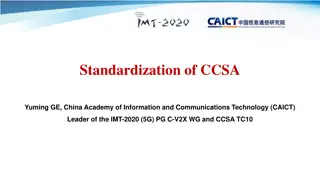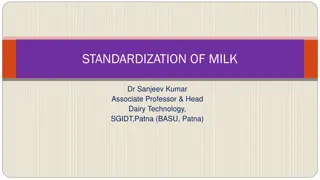
Mastering Standardization Methods in Epidemiological Research
Discover the power of standardization in epidemiological research to control confounding variables and accurately compare disease or mortality rates between populations. Dive into direct and indirect standardization techniques like Standardized Mortality Ratio (SMR) with detailed examples and advantages over direct methods.
Download Presentation

Please find below an Image/Link to download the presentation.
The content on the website is provided AS IS for your information and personal use only. It may not be sold, licensed, or shared on other websites without obtaining consent from the author. If you encounter any issues during the download, it is possible that the publisher has removed the file from their server.
You are allowed to download the files provided on this website for personal or commercial use, subject to the condition that they are used lawfully. All files are the property of their respective owners.
The content on the website is provided AS IS for your information and personal use only. It may not be sold, licensed, or shared on other websites without obtaining consent from the author.
E N D
Presentation Transcript
What is Standardization ? Standardization, is a method for overcoming the effect of confounding variables in epidemiological research. In epidemiological studies we often compare the incidence of disease or mortality between two or more populations. However, the comparison of crude mortality or morbidity rates is often misleading because the populations being compared may differ significantly with respect to certain characteristics, such as age or sex, that will affect the overall rate of morbidity or mortality
Types of Standardization Direct Indirect
INDIRECT STANDARDIZATION commonly used when age-specific rates are unavailable. In this method, instead of taking one population structure as standard and applying sets of rates to it to estimate expected events, a set of rates from a standard population is applied to each of the observed populations.
INDIRECT STANDARDIZATION Divided into 2 forms Standardized mortality ratio (SMR) 1. 2. Other Standardization techniques
STANDARDIZED MORTALITY RATIO SMR = Observed Deaths X 100 Expected Deaths It is a ratio of the total number of deaths that occur in the study group to the number of deaths that would have been expected to occur if that study group had experienced the death rates of a standard population.
From table the SMR is calculated as 160, which means that the number of observed deaths in Country B is 60% higher than the number we would expect if Country B had the same mortality experience as Country A.
Advantage over direct method Permits adjustment of age and other factors where age specific rates are unavailable. Only the number of people in each age group in the study population and the age specific rates of the standard population is needed Can also be used to calculate disease occurrence instead of death
Other Standardization Techniques A more complicated method of indirect adjustment that yields absolute age adjustment rate, involves the calculation of an index death rate and a standardizing factor for each population of interest a) Life table : an age-adjusted summary of current all- causes mortality b) Regression techniques : efficient means of standardization c) Multivariate analysis : a computer which using regression or other methods can standardize or several variables simultaneously d)






















